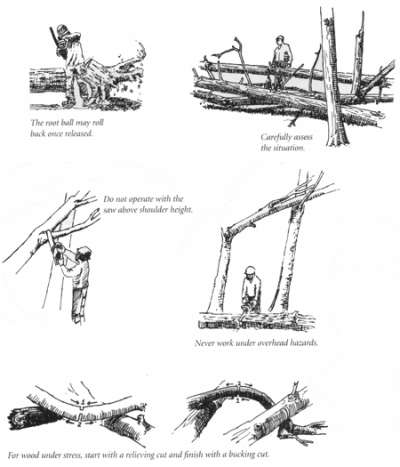Violent windstorms are common in the Northeast, and they often leave behind blown-down trees that need to be removed. But before you charge in with your chainsaw revving, a careful assessment of the situation is warranted. Removing blowdowns can be very dangerous. A tangle of blown-down trees contains wood that is under stress and that will react violently when the stress is released.
Examine the downed trees to identify which wood is under stress. Stress is stored energy that can be released suddenly when a trunk or limb is cut. Most commonly, it is created by compression (pushing together) or tension (pulling apart) of wood fibers. You can test for stress by making a small cut into a stem and watching what happens. If the cut closes, it is under compression. If it opens, it is under tension. Understanding these forces will help you to avoid binding your saw or exposing yourself to injury as you continue cutting.
Bent limbs, limbs in contact with the ground or other trees, or small trees trapped under a fallen tree are most likely under stress. Boles trapped by adjacent stems or stumps or lying on a slope can jump, pivot, or slide when cut. One stress often overlooked is that caused by the root ball in trees that have been completely uprooted. This heavy wad of dirt, stones, and roots can be unpredictable and may roll or fall back into its hole when it is released.
Work safely. Always keep both feet firmly planted on the ground when cutting. Do not allow your feet to become tangled in brush, and do not work in confined spaces. Always have an escape route. Work from the uphill side or away from the direction where the tree may roll.
Attack the job methodically. First, cut and remove limbs that are not under stress, and then start with the smallest and easiest-to-reach stems. By working methodically, you will gradually lessen the stress on the remaining wood and give yourself more room to operate.
For wood under stress, always start with a relieving cut on the compression side of the log or stem. A V-shaped notch on this side will release the pressure gradually and help keep the saw from binding. Finish with a final cut from the tension side.
Bent limbs can be controlled by gradually shaving them on the compression side until they fold. When cutting limbs in contact with the ground, be aware that the trunk may drop, spin, or pivot when the limb is released, and position yourself so that you will not be struck. Always remember that in any situation, your safety is the highest priority.


